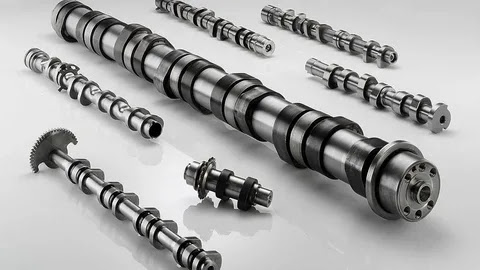What is Camshaft?
A camshaft is a piece of machinery that converts circular or rotational motion into reciprocating or oscillatory motion. Since the Hellenistic period in the third century BC, such devices have been used as toys that mechanically execute repetitive tasks and subsequently in automated music boxes for hitting a hammer in a pre-programmed manner to create a tune. The opening and shutting off of fuel valves in nearly all piston-driven internal combustion engines are one of the most frequently utilised uses of camshafts today.
Function Of Camshaft
A camshaft in an internal combustion engine allows the engine's valves to open and shut. The camshaft is a cylinder that lines up with the cylinders in the engine. The camshaft's uneven lobes match the engine's valves. The camshaft revolves, around opening and closing the valves of the engine.
The timing belt connects the camshaft to the engine's crankshaft. The timing belt and camshaft operate in tandem to open the valves with the pistons' stroke. Timing belts should be inspected and adjusted regularly. The camshaft stops rotating when the timing belt breaks. When this happens, pistons may hit a closed valve, thereby killing the engine.
Mechanics Of A Camshaft
The device consists of a shaft with cams placed around it throughout its length. Each cam is eccentric, with a bulge rather than a uniform round disc. This allows the bulge to push on a follower once for every full rotation of the shaft around its axis.
Valve Timing
The timing of the opening and shutting of the fuel injection and gas exhaust valves in internal combustion engines is critical. They must sync with the piston's motion to ensure proper engine strokes. This is achieved by using the camshaft to open and close the valves at predetermined intervals.
Camshaft Operation
The camshaft is intended to spin twice for every crankshaft revolution, and four-valve actions occur for each camshaft rotation. The intake valves are opened by cams on the camshaft during the intake stroke and closed at the start of the compression stroke. The crankshaft has completed one revolution after the compressed fuel has been ignited.
Change on the Horizon
Camshaft manufacturing companies in India enable more advanced valve technology to change the valves' timing, duration and lift. This control may enhance fuel economy, boost power, and decrease emissions depending on the circumstances.
In recent years, there has been much advancement in engine design. Almost every Camshaft manufacturing company uses it and works on many different aspects of the engine timing system. Oil pressure was utilised in one of the earliest methods to control valve operation.
Advantages in Numbers
An engine may have a different number of camshafts depending on its cylinder layout and valve function. Because each cylinder bank requires at least one camshaft, inline engines may utilise as little as one, while V engines need at least two. Double overhead camshafts are used in specific machines. Thus there might be as many as four spanning two banks of cylinders.

Comments
Post a Comment